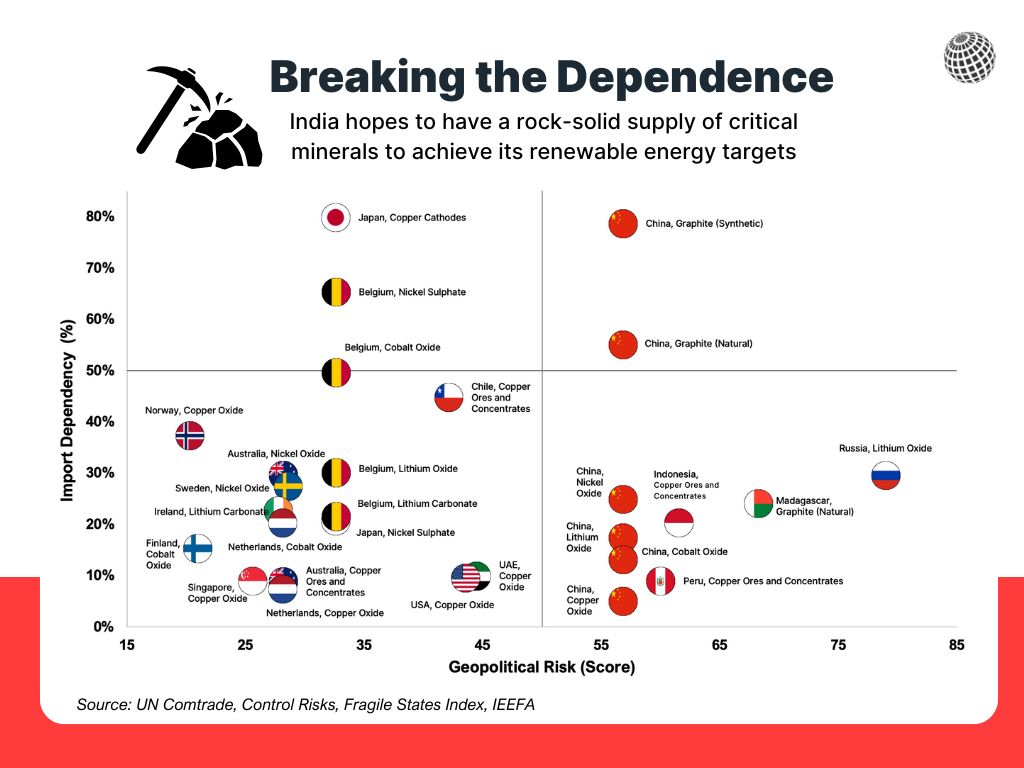India needs to diversify its critical mineral sourcing strategy

The country has a high import dependence for minerals key to accelerate its energy transition
Key Takeaways:
Minerals at risk – with high import dependency and reliance on a few countries – include synthetic and natural graphite, lithium oxide, nickel oxide, nickel sulphate and copper cathodes. The procurement strategy of these minerals needs intervention to diversify the sources.
India’s import dependency will likely continue as the demand for critical minerals is expected to more than double by 2030, while domestic mines will take more than a decade to start producing.
India can deepen its strategic partnerships with geopolitically stable countries and increase its procurement of minerals from them. The country can explore investment opportunities in resource-rich, friendly nations, such as Australia, Chile and some African countries like Ghana and South Africa.
28 October 2024 (IEEFA South Asia): India needs to carefully craft its import strategy to circumvent potential trade risks while balancing international ties for procuring minerals critical to accelerating its energy transition, a new report by the Institute for Energy Economics and Financial Analysis (IEEFA) states.
IEEFA’s report examines five critical minerals (and their compounds) – cobalt, copper, graphite, lithium and nickel – from the perspective of import dependency, trade dynamics, domestic availability and global price fluctuations. It finds that India remains largely dependent on imports for these minerals and their compounds, with 100% import dependency for minerals like lithium, cobalt and nickel.
Further, the report notes that the demand for critical minerals is expected to more than double by 2030, while domestic mines will take more than a decade to start producing.
“India should strive to de-risk its critical minerals sourcing by identifying new international resources and expediting domestic production. A concerted effort to partner with and foster bilateral relations with mineral-rich nations should be a priority for India,” says the report’s co-author Charith Konda, Energy Specialist, IEEFA.
“The country can also explore investment opportunities in resource-rich, friendly nations, such as Australia and Chile, as well as African countries like Ghana and South Africa,” he adds.
Regarding specific minerals, the report identifies synthetic graphite and natural graphite as ones that need a policy intervention to diversify procurement sources.
“For both variants of graphite, India depends heavily on China. Mozambique, Madagascar, Brazil, and Tanzania are some countries with the highest graphite production. As part of the Global South cooperation initiatives, these countries could be favourable partners for India for graphite trading,” says the report’s co-author Kaira Rakheja, Energy Analyst, IEEFA.
India is also highly import-dependent for copper cathodes and nickel sulphates, from just two countries – Japan and Belgium. The report suggests India could look at the U.S., the fifth largest producer of copper in the world, to diversify its suppliers and enhance supply security.
For minerals like lithium oxide and nickel oxide, the dependency is low on one country, but overall imports largely come from Russia and China, both countries with potential trade risks.
“Developing domestic lithium refining capacity will help India integrate with the global lithium supply chain,” says Rakheja.
The report also notes the significant efforts that the Indian government is making to bolster domestic production of critical minerals with the auctions by the Ministry of Mines and the planned Critical Minerals Mission.
“The critical minerals mining block auctions can serve as an opportunity for India to focus on building refining and processing capabilities to emerge as a global value-adding hub,” says Rakheja.
“Government support in the form of viability gap funding and technology development will help promote such auctions and ultimately the domestic production of critical minerals. A stable supply of critical minerals is imperative for India to achieve its renewable energy goals,” says Konda.
Read the report: India’s Hunt for Critical Minerals
Media contact: Prionka Jha ([email protected]); +91 9818884854
Author contacts: Charith Konda ([email protected]), Kaira Rakheja ([email protected])
About IEEFA: The Institute for Energy Economics and Financial Analysis (IEEFA) examines issues related to energy markets, trends and policies. The Institute’s mission is to accelerate the transition to a diverse, sustainable and profitable energy economy. (ieefa.org)










